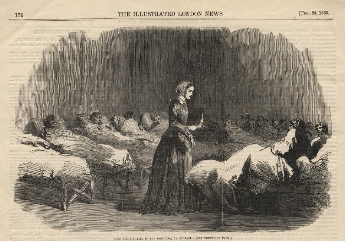
February 26, 2019, by Jonathan Memel
‘Mythical Florence’: Where Does the Lady with the Lamp Stand Today?
In this piece for the AHRC, also published on their blog, Dr Jonathan Godshaw Memel describes Nightingale’s uncomfortable relationship with public representations of herself.
Florence Nightingale remains curiously familiar to us today. Whether or not she intended it herself, her fame has lasted well beyond her lifetime. But where do depictions of the Lady with the Lamp originate and why have they proved so enduring?
On a recent trip to London our research team passed the bronze statue of Nightingale that stands at the Crimean War Memorial in Waterloo Place.
Nightingale stands in the cap and linen collar and cuffs that she wore at the Barrack Hospital, Scutari. And, of course, she holds the lamp for which she became famous.
Set into the pedestal are four scenes that interpret the figure of Nightingale standing above. As we walked around the statue, we saw that each scene depicted key roles that she played during her lifetime: caring for the sick, challenging politicians and generals, negotiating with medical and hospital managers, and teaching and inspiring nurses.
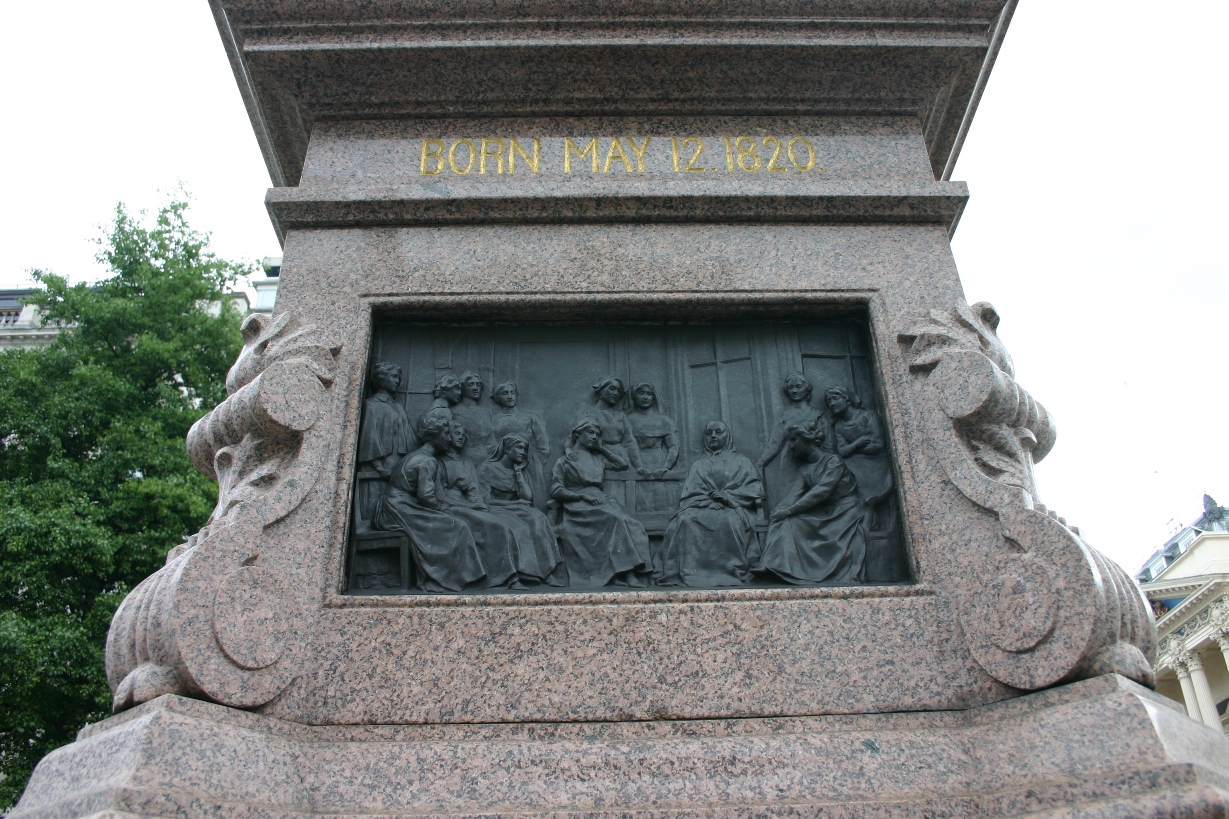
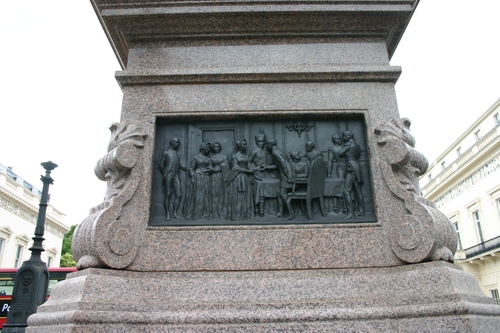

Photos by Luca Borghi, 2011
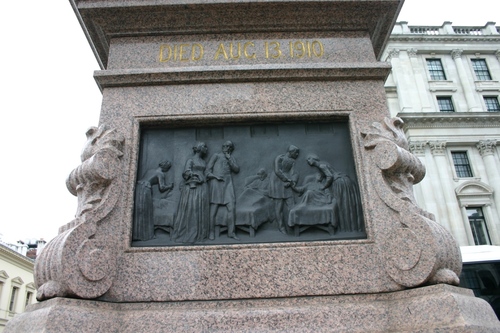
Unveiled to the public in 1915, the statue is the work of the British sculptor Arthur George Walker. Like any artist, Walker was influenced by images that came before him. And few Victorians had been represented as much as Nightingale.
An 1855 feature in the Illustrated London News showed her tending to injured soldiers in a Crimean hospital. However, her mythic status was granted by Henry Wadsworth Longfellow in his poem ‘Santa Filomena’, which predicted that ‘A Lady with a lamp shall stand/ In the great history of the land’.

‘Florence Nightingale’. Wood engraving, published in Illustrated London News. Oil painting by Jerry Barrett.
That’s not to say that Nightingale encouraged all of the attention. Facing persistent requests by Jerry Barratt, painter of ‘The Mission of Mercy’ (now held at the National Portrait Gallery), to sit for her portrait, Nightingale responded: ‘I have determined in no way to forward the making a show of myself or of any person,’ before adding, ‘though I cannot always prevent them or me being made a show of’.
In the nineteenth century Nightingale played an important role in the stories that brought national, religious, and professional communities together. So, we asked ourselves, in what kind of stories does Nightingale feature today?
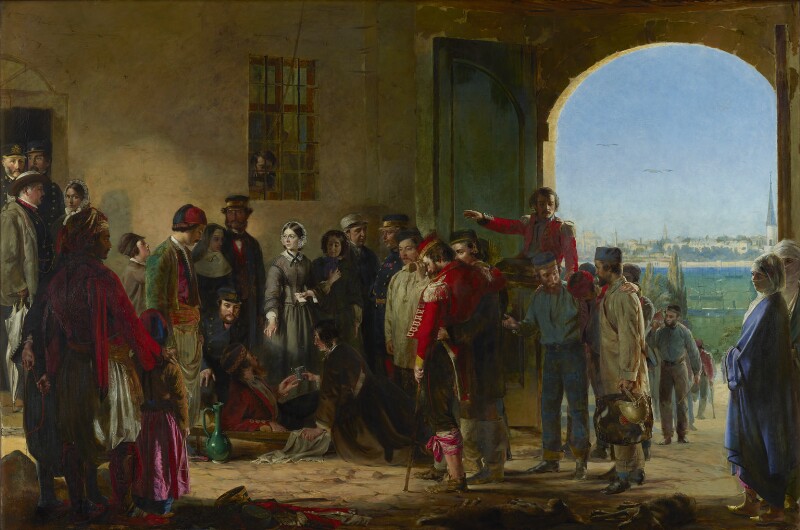
‘The Mission of Mercy: Florence Nightingale Receiving the Wounded at Scutari’, 1857. Oil painting by Jerry Barrett.
We soon had to leave the statue behind and head over to the Queen’s Nursing Institute (QNI), a charity that forms one of Nightingale’s many legacies today. The QNI follows Nightingale’s example by supporting the care of people in their own homes.
With our AHRC-funded project – Florence Nightingale Comes Home for 2020 – we are particularly interested in the local dimension of these acts of representation and remembrance
Did the famous 1850s depictions make up the entirety of what Nightingale’s sister Parthenope called ‘Mythical Florence’? Or did Nightingale’s reception show regional variation, with different communities in Britain and around the world understanding her in different ways?
How was Nightingale received and then remembered in Derbyshire, an area in which her family lived and were known? Our project’s touring exhibition, school learning sessions, and publications will respond to these questions in 2020, the bi-centenary of Nightingale’s birthday.
‘Lea Hurst: Home of Florence Nightingale’, n.d., photograph by Francis Frith.
Notes
- Image 1Photo by Jonathan Memel, 2018. This image is released by Memel under a Creative Commons licence (CC BY-SA 3.0)
- Image 2Photos by Luca Borghi, 2011. This image is released by Borghi under a Creative Commons licence (CC BY-SA 3.0)
- Image 3Florence Nightingale’. Wood engraving, published in Illustrated London News. Oil painting by Jerry Barrett. This image is released by the National Portrait Gallery under a Creative Commons licence (CC BY-NC-ND 3.0)
- Image 4‘The Mission of Mercy: Florence Nightingale Receiving the Wounded at Scutari’, 1857. Oil painting by Jerry Barrett. This image is released by the National Portrait Gallery under a Creative Commons licence (CC BY-NC-ND 3.0)
- Image 5‘Lea Hurst: Home of Florence Nightingale’, n.d., photograph by Francis Frith. Copyright owned by the Victoria and Albert Museum, London (acquired from F. Frith and Company in 1954)
- ‘I have determined…’: Letter from F. Nightingale to J. Barrett, 18 July 1856. London Metropolitan Archives (H01/ST/NC /03/SU/E/193)
- ‘Mythical Florence’: Letter from Parthenope Nightingale to Richard Monckton Milnes, 12 September [1855]. Houghton Papers, Trinity College Library, Cambridge (18/151)

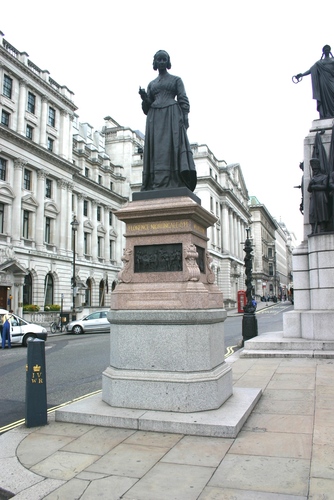

I found your website from Google and also I have to state it
was an excellent locate. Thanks!
Your site has excellent content. I bookmarked the site